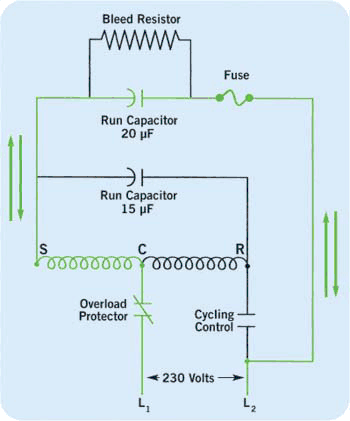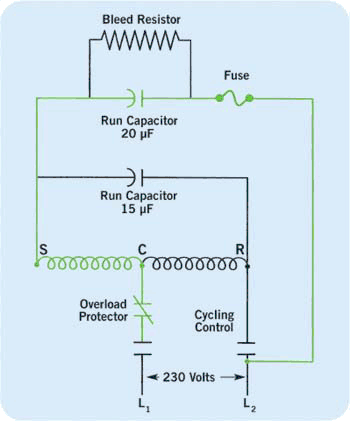The contactor arrangement can be single pole, double pole, or triple pole, depending on the phase and application. Many residential and light commercial air conditioning systems, as well as some packaged open- and closed-loop water-source heat pump systems, use a single-pole contactor along with dual-run capacitors (Figure 1).

A Dual Purpose
As the name implies, dual-run capacitors serve a dual purpose. During the off cycle (Figure 1), alternating current charges and discharges the 20-microfarad run capacitor 60 times per second (60 hertz) through the start winding (between S and C). This current is shown in green in Figure 1. This allows the start winding to act as a small crankcase heater during the off cycle.As long as power is supplied to lines 1 and 2 through the disconnect switch and the contactor’s contacts are opened, the crankcase heater will be energized.
Many manufacturers recommend crankcase heat during the off cycles and at least 24 hours before seasonal startups. This warms the crankcase and drives out any refrigerant that has migrated to the oil in the crankcase. This helps prevent foaming of the oil in the compressor’s crankcase on start-ups, which can score bearings and may cause slugging of refrigerant and/or oil. (Migration and slugging are covered at the conclusion of this article.)
A second purpose for the dual-run capacitor is to act as one larger capacitor wired between the run and start windings during the run cycle. This is referred to as a permanent split capacitance (PSC) motor. Remember, capacitors wired in parallel add in capacitance. So, in Figure 2 the motor sees both the 20- and 15-microfarad capacitor in parallel. Both are wired between the run and start windings (R and S). This gives the motor 35 microfarads (15 + 20) for running and starting torque. Both capacitors are wired in parallel with the run winding, and in series with the start winding.
The green line in Figure 3 shows an incomplete circuit. This is why it is of utmost importance for service technicians to recognize off-cycle crankcase heat when changing contactors.
Never change a single-pole contactor for a double-pole contactor when this type of circuit is used, because it will render the off-cycle crankcase heater useless. This will eventually lead to compressor damage because there is no crankcase heat to rid the crankcase of refrigerant that has migrated during off cycles and long shutdowns. Compressor slugging can occur.

Migration
Migration is what happens when liquid or vapor refrigerant returns to the compressor’s crankcase or suction line during the off cycle. Migration only occurs during the off cycle of the compressor. Causes could include:During the compressor’s off cycle, liquid and vapor refrigerant tend to migrate to the compressor’s crankcase; once there, the refrigerant lays under the oil. Refrigeration oil has a much lower vapor pressure than liquid or vapor refrigerant; thus, migration or flow of refrigerant to the compressor takes place because this is where the lowest pressure exists.
If the compressor is located in a cold ambient environment, migration will take place much faster. Migration can even take place from a suction line accumulator to a compressor because of the difference in vapor pressure.
Because migration can take place as a vapor, the refrigerant can flow uphill or downhill. Once the refrigerant vapor reaches the crankcase, it will condense and settle to the bottom of the crankcase under the oil only if the compressor remains off long enough. Oil and refrigerant are very soluble in one another. During short off cycles, the refrigerant will not have a chance to settle under the oil but will mix with the oil. When the compressor turns on, the sudden crankcase pressure drop will cause the oil-refrigerant mixture in the crankcase to flash. The oil level in the crankcase will drop and mechanical parts can be scored.
Oil foaming now occurs, and a combination of oil and refrigerant can be forced around piston rings and pumped by the compressor. High current draws, motor overheating, and broken valves can result.
The only sure remedy for compressor migration is an automatic pumpdown system. Clear all refrigerant (liquid and vapor) from the evaporator and suction line before every off cycle. Automatic pumpdown is accomplished with a thermostat controlling a liquid-line solenoid in combination with a low-pressure controller terminating the on cycle once the evaporator and suction lines are void of any refrigerant. This ensures that there is no refrigerant in the evaporator or suction line to migrate towards the compressor.
However, during long seasonal shutdowns, automatic pumpdown systems are not the answer. The answer is to energize the crankcase heater for at least 24 hours while the system is off.
It is often thought that having a crankcase heater will prevent migration. Crankcase heaters will keep the compressor’s crankcase warm and prevent migration to the compressor’s oil. However, condensed migrated refrigerant will be driven from the compressor and will sit in the suction line near the compressor, waiting for the next on cycle. If an excessive amount of liquid refrigerant has been driven to the suction line, severe liquid slugging may occur during startup. Compressor damage can include broken valves and damaged pistons.

Slugging
Crankcase heaters can be effective in combating migration, but they won’t remedy slugging at startups from liquid floodback unless they are used in conjunction with a properly sized suction line accumulator.Slugging is what happens when liquid refrigerant (or liquid refrigerant and oil) enters the compressor’s cylinder during an on cycle.
Causes of slugging include:
Air-cooled semi-hermetic compressors are more prone to slugging than are refrigerant-cooled semi-hermetics. Refrigerant is often drawn directly into an air-cooled semi-hermetic’s cylinder without passing through the motor barrel. Slugging can result in broken valves, head gaskets, and connecting rods, and compressor damage in general.
Refrigerant-cooled semi-hermetic compressors often draw liquid from the suction line through hot motor windings in the motor barrel, which assists in vaporizing any liquid. Even if liquid refrigerant gets past the motor windings, the check valve in the partition between the crankcase and the motor barrel will prevent any liquid refrigerant from entering the crankcase. High current draws (from dense refrigerant vapors entering the compressor cylinder) will be noticeable.
Most hermetic compressor suction lines end at the shell of the compressor. If liquid refrigerant enters the compressor, liquid will fall directly into the crankcase oil and will be flashed eventually. This is called flooding. It causes oil to foam and results in excessively high crankcase pressures. Refrigerant and oil droplets can then reach the compressor’s cylinder; slugging is the result.
Slugging in hermetic compressors can occur also from a migration problem. As mentioned be-fore, foaming oil and refrigerant in the crankcase due to migration will generate excessive crankcase pressures during the on cycle. These oil and refrigerant droplets can get past piston rings and other small openings and enter the compressor’s cylinder. The result is slugging. Slugging can damage reed valves, piston rods, bearings, and many other compressor parts.
Tomczyk is a professor of HVAC at Ferris State University, Big Rapids, Mich., and the author of Troubleshooting and Servicing Modern Air Conditioning & Refrigeration Systems, published by ESCO Press. To order, call 800-726-9696. Tomczyk can be reached at tomczykj@tucker-usa.com.
Publication date: 08/04/2003

Report Abusive Comment